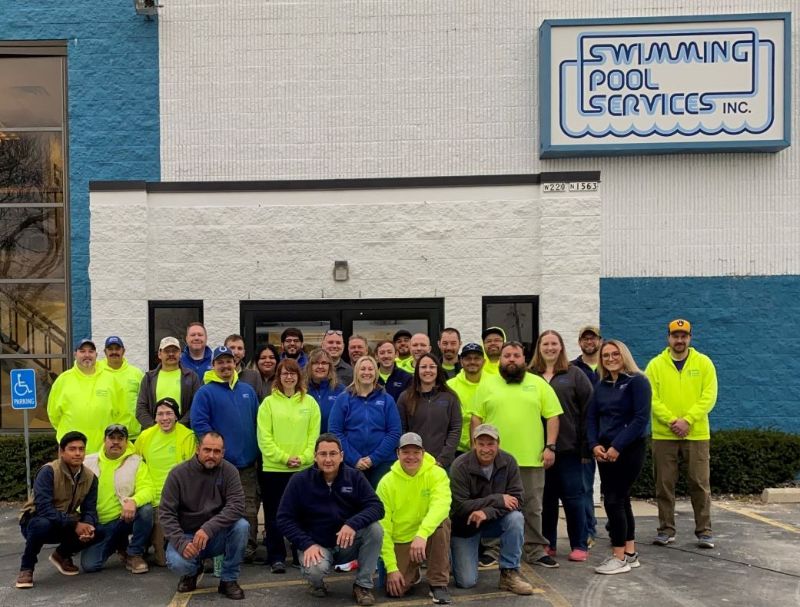Latest News
Growth by Addition

( This article and images were originally published on the PHTA website click here )
How one design/build contractor turned services from a seasonal headache into a year-round moneymaker
Dave Thompson’s father built his pool construction company from the ground up in the 1960s. Thompson was proud—but it wasn’t for him, he thought.
“Business in our industry in Wisconsin was very seasonal, which meant at that time, we worked 80 to 100 hours a week in the summer and then you either ice-fished or went somewhere warm and played golf in the winter,” he recalls. “I didn’t really want that lifestyle.”
When it was Thompson’s turn to step up to run the business with his brother, he vowed to change. His goal: A year-round business with more manageable hours.
Swimming Pool Services Inc. of Southeastern Wisconsin was about to be transformed.
Step 1: Set up a dedicated service unit
What was once a headache for the construction arm of the business—fixing things that broke on pools during the summer—became its own business unit.
Today the unit has 20 people who open, close, and maintain pools. It accounts for one-third of the company’s annual $9 million revenue.
“It’s amazing what our team is able to do,” Thompson says.
That was a drastic transition from work Thompson says his team did “begrudgingly” in the past and without the proper resources.
Step 2: Hire people fit for the service business
If you’re thinking of adding service to your existing construction business using the same people, think again, Thompson cautions.
“It’s a different mindset,” he says, adding the work is physically easier but keeps employees outdoors in all weather conditions and brings them face-to-face with customers.
“The service team maintains the customer relationship,” Thompson says.
Finding the right people for the service role may mean looking outside your existing team. When Thompson started the process, he said he had to remove people who didn’t fit.
One place he’s looked for those with the soft skills for service? The food industry, especially as it contracted since the pandemic, because it prepares employees to communicate and problem solve.
Step 3: Create vendor relationships that enable your service arm
When he first started to grow his service business, Thompson found it was very difficult to predict and have the supplies needed to service even the pools his company built.
“So we started basically stocking up” and building vendor relationships, he says.
Doing that through the pandemic has saved him from the supply chain disruption.
“Our mantra is to make it easy for people to get a pool installed and also own it. Our mission is to allow them to enjoy a private paradise in their backyard, and we need that stuff to be able to make that happen,” Thompson says.
Step 4: Empower your leadership team to own their work so you can focus on the big picture
Without formal business training, Thompson says he’s received leadership training from the Pool & Hot Tub Alliance (PHTA).
Just as he learned from his early mistakes, Thompson believes in letting his managers do the same. The result: a service unit that runs itself and has the company’s highest margins.
“As long as it doesn’t burn the building down and put us out of business, mistakes are good. If you’ve got the right people and you trust them, they’re going to learn.”
Step 5: Add ancillary services that prevent seasonal dips
To keep the service team employed year-round, Thompson added a Christmas lights business—something his managers encouraged him to do. Employees previously furloughed from November 15 to March 15 now work through February installing and uninstalling light displays, leaving them with just about a month of downtime before pool and hot tub season begins.
Thompson credits PHTA and his local industry groups with inspiring the idea in the first place and connecting him to a franchise opportunity.
“It’s always good to get together with somebody who’s going through the same things you are,” he says. “You can learn a lot from each other.”
Step 6: Use your business relationships to keep growing
After 15 years of growing through the hard work of the first five steps, Thompson found new growth started finding him through PHTA and other relationships.
When local competitors get behind with their service calls, Thompson is the first person they turn to in part because he “always tries to get along with everybody in the market.”
This past fall, Thompson saw 20% growth in pool closings when the owner of a local competitor passed away unexpectedly, and the company’s management needed to hand off accounts. It was a big market share boost.
“You’ve got to have the capacity to take (the work), so you have to start with a growth mentality,” Thompson says. “Because there’s going to be an opportunity for more.”
Even if the economy does take a downturn in 2023, Thompson says a great integrated service business is less likely to be impacted than one that is doing construction alone.

